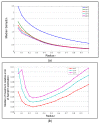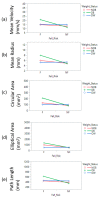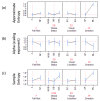Dynamical Properties of Postural Control in Obese Community-Dwelling Older Adults †
- PMID: 29794998
- PMCID: PMC6021983
- DOI: 10.3390/s18061692
Dynamical Properties of Postural Control in Obese Community-Dwelling Older Adults †
Abstract
Postural control is a key aspect in preventing falls. The aim of this study was to determine if obesity affected balance in community-dwelling older adults and serve as an indicator of fall risk. The participants were randomly assigned to receive a comprehensive geriatric assessment followed by a longitudinal assessment of their fall history. The standing postural balance was measured for 98 participants with a Body Mass Index (BMI) ranging from 18 to 63 kg/m², using a force plate and an inertial measurement unit affixed at the sternum. Participants' fall history was recorded over 2 years and participants with at least one fall in the prior year were classified as fallers. The results suggest that body weight/BMI is an additional risk factor for falling in elderly persons and may be an important marker for fall risk. The linear variables of postural analysis suggest that the obese fallers have significantly higher sway area and sway ranges, along with higher root mean square and standard deviation of time series. Additionally, it was found that obese fallers have lower complexity of anterior-posterior center of pressure time series. Future studies should examine more closely the combined effect of aging and obesity on dynamic balance.
Keywords: nonlinear; obesity; postural control.
Conflict of interest statement
The authors declare no conflict of interest.
Figures






Similar articles
-
Assessment of postural balance in community-dwelling older adults - methodological aspects and effects of biofeedback-based Nintendo Wii training.Dan Med J. 2014 Jan;61(1):B4775. Dan Med J. 2014. PMID: 24393594 Clinical Trial.
-
The effects of obesity and standing time on postural sway during prolonged quiet standing.Ergonomics. 2009 Aug;52(8):977-86. doi: 10.1080/00140130902777636. Ergonomics. 2009. PMID: 19629812
-
Increased postural sway during quiet stance as a risk factor for prospective falls in community-dwelling elderly individuals.Age Ageing. 2017 Nov 1;46(6):964-970. doi: 10.1093/ageing/afx083. Age Ageing. 2017. PMID: 28531243
-
The contribution of postural balance analysis in older adult fallers: A narrative review.J Bodyw Mov Ther. 2016 Apr;20(2):409-17. doi: 10.1016/j.jbmt.2015.12.008. Epub 2015 Dec 18. J Bodyw Mov Ther. 2016. PMID: 27210860 Review.
-
Center of pressure displacement characteristics differentiate fall risk in older people: A systematic review with meta-analysis.Ageing Res Rev. 2020 Sep;62:101117. doi: 10.1016/j.arr.2020.101117. Epub 2020 Jun 19. Ageing Res Rev. 2020. PMID: 32565327
Cited by
-
Diagnostic Balance Tests for Assessing Risk of Falls and Distinguishing Older Adult Fallers and Non-Fallers: A Systematic Review with Meta-Analysis.Diagnostics (Basel). 2020 Sep 3;10(9):667. doi: 10.3390/diagnostics10090667. Diagnostics (Basel). 2020. PMID: 32899201 Free PMC article. Review.
-
Walking and postural balance in adults with severe short stature due to isolated GH deficiency.Endocr Connect. 2019 Apr;8(4):416-424. doi: 10.1530/EC-19-0103. Endocr Connect. 2019. PMID: 30865930 Free PMC article.
-
Predictive Validity of Motor Fitness and Flexibility Tests in Adults and Older Adults: A Systematic Review.J Clin Med. 2022 Jan 10;11(2):328. doi: 10.3390/jcm11020328. J Clin Med. 2022. PMID: 35054020 Free PMC article. Review.
-
Effects of a Randomized Home-Based Quality of Movement Protocol on Function, Posture and Strength in Outpatients with Obesity.Healthcare (Basel). 2021 Oct 27;9(11):1451. doi: 10.3390/healthcare9111451. Healthcare (Basel). 2021. PMID: 34828497 Free PMC article.
-
The usefulness of Integrative Neuromuscular Training to counteract obesity: a narrative review.Int J Obes (Lond). 2024 Jan;48(1):22-32. doi: 10.1038/s41366-023-01392-4. Epub 2023 Sep 30. Int J Obes (Lond). 2024. PMID: 37775520 Free PMC article. Review.
References
-
- Lockhart T., Frame C., Soangra R., Lach J. Fall Risk Prediction Using Wearable Wireless Sensors. SPIE Newsroom; Bellingham, WA, USA: 2014.
MeSH terms
LinkOut - more resources
Full Text Sources
Other Literature Sources
Medical

